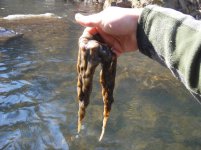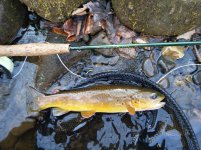3wt7X
Active member
- Joined
- Nov 19, 2008
- Messages
- 667
A recent trip to the Savage River displayed a terrible truth, the didymo problem has not only been confirmed on the Savage, but it has also spread like wildfire. I went out there to enjoy the warmer temperatures that we've been having. I was aware that didymo was located in the river, but I did not realize that it had spread to the point where you could hardly nymph it.
I started the day fishing a tandem nymph rig with a black pheasant tail and midge patterns in an attempt to emulate the tiny black stones. I immediately noticed the "rock snot" and I was cleaning my nymphes every other cast. It got to the point were I simply gave up nymphing. I did notice plenty of tiny black stones on banks and in the wooded areas around the stream, so I switched over to a dry fly despite not seeing any appearent risers. I ended up having a very enjoyable day, catching 8 browns in about 5 hours on top, but I could not help but feel bad for the river that I love. Sorry, I only took one picture of the didymo, but I can attest that it was covering nearly all the rocks and it is definatley going to be a big problem. Needless to say, I spent sometime cleaning my gear when I got home. :-(
I started the day fishing a tandem nymph rig with a black pheasant tail and midge patterns in an attempt to emulate the tiny black stones. I immediately noticed the "rock snot" and I was cleaning my nymphes every other cast. It got to the point were I simply gave up nymphing. I did notice plenty of tiny black stones on banks and in the wooded areas around the stream, so I switched over to a dry fly despite not seeing any appearent risers. I ended up having a very enjoyable day, catching 8 browns in about 5 hours on top, but I could not help but feel bad for the river that I love. Sorry, I only took one picture of the didymo, but I can attest that it was covering nearly all the rocks and it is definatley going to be a big problem. Needless to say, I spent sometime cleaning my gear when I got home. :-(






